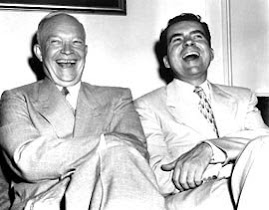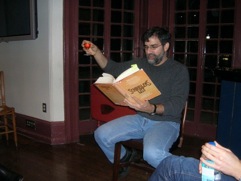Marcel Duchamp on painting: "I don't believe in the magic of the hand." Q. "Why did you retire from the world of art?" A. "I couldn't tell you why. I never had any why... Painting always bored me."
From a television interview conducted by Russell Connor on the occasion of the Boston Museum of Fine Arts exhibit of the work of Duchamp’s brother, Jacques Villon, 1964.
Here are the full details about the video:
Marcel Duchamp Interviewed by Russell Connor
Museum of Fine Arts Boston in association with WGBH-TV
1964, 29:02 min, b&w, sound
Russell Connor interviews Marcel Duchamp on the occasion of the Boston Museum of Fine Art's exhibition of the work of Duchamp's brother, "Impressionist-Cubist" Jacques Villon (formerly Gaston Duchamp). Connor first introduces paintings, etchings, sculpture and lithographs by Villon, and is then joined by Duchamp, who discusses Villon's work and contributes his thoughts on art in general. This fascinating document gives the viewer a rare opportunity to hear the legendary Dadaist as he reveals observations on the state of art in the 1960's.
Presented by Museum of Fine Arts, Boston in association with WGBH-TV, Boston and the Livell Institute Cooperative Broadcasting Council. Director: Allan Hinderstein. Lighting Director: Linda Beth Hepler. Video: Al Potter. Audio: Will Morton. Recordist: Pat Kane. Associate Producer: Thalia Kennedy. Executive Producer: Patricea Barnard.
Buy it here: LINK.
Showing posts with label Duchamp. Show all posts
Showing posts with label Duchamp. Show all posts
Tuesday, December 22, 2009
Saturday, October 24, 2009
no ideas but what's from the hardware store
 In Paris very recently (yesterday?), two of my students - Lily and Alex - pay appropriate non-respects to one of the Duchamp "Fountain" reproductions. Their own caption: they laughed so hard (not at Duchamp but at themselves for their response to coming up it) that they peed in their pants. Better in their pants, I say, than in the urinal.
In Paris very recently (yesterday?), two of my students - Lily and Alex - pay appropriate non-respects to one of the Duchamp "Fountain" reproductions. Their own caption: they laughed so hard (not at Duchamp but at themselves for their response to coming up it) that they peed in their pants. Better in their pants, I say, than in the urinal.
Wednesday, March 11, 2009
ut pictura poesis descends a staircase
 Here's X. J. Kennedy's "Nude Descending a Staircase," published in 1959 or 1960. From the title we know that Kennedy was in some sense at least rewriting or reworking the image of Duchamp's great early modern kinetic-cubist painting of the same name. I could go on and on about this poem as a 1950s-style poetical quietism. I won't here. Maybe what one can say on this score will be obvious. Whereas in the Duchamp the subject position is everywhere at once (we are seeing the nude from all angles - she moves and thus our rendering of her must be dynamic), here we are watching her from below - down the stairs. (In porn-ish pics I believe this is called "upskirt." Google that word and watch out.) From that vantage "we" watch her thighs rub together and although there's "the swinging air" the image is static. We've seen her, spied her. rendered her. Her descent is likened (it is not itself but something like it) and then, in the final line of the poem, the motion is not motion, but has a definitive end. Her motions are collected into a shape, a metered and rhymed who-has-zoomed-who unmistakable shape. This poem about a painting about constant mimesis-defying movement ironizes that kind of movement.
Here's X. J. Kennedy's "Nude Descending a Staircase," published in 1959 or 1960. From the title we know that Kennedy was in some sense at least rewriting or reworking the image of Duchamp's great early modern kinetic-cubist painting of the same name. I could go on and on about this poem as a 1950s-style poetical quietism. I won't here. Maybe what one can say on this score will be obvious. Whereas in the Duchamp the subject position is everywhere at once (we are seeing the nude from all angles - she moves and thus our rendering of her must be dynamic), here we are watching her from below - down the stairs. (In porn-ish pics I believe this is called "upskirt." Google that word and watch out.) From that vantage "we" watch her thighs rub together and although there's "the swinging air" the image is static. We've seen her, spied her. rendered her. Her descent is likened (it is not itself but something like it) and then, in the final line of the poem, the motion is not motion, but has a definitive end. Her motions are collected into a shape, a metered and rhymed who-has-zoomed-who unmistakable shape. This poem about a painting about constant mimesis-defying movement ironizes that kind of movement.Here you go:
Nude Descending a Staircase
Toe upon toe, a snowing flesh,
A gold of lemon, root and rind,
She sifts in sunlight down the stairs
With nothing on. Nor on her mind.
We spy beneath the banister
A constant thresh of thigh on thigh--
Her lips imprint the swinging air
That parts to her parts go by.
One-woman waterfall, she wears
Her slow descent like a long cape
And pausing, on the final stair
Collects her motions into shape.
Labels:
1950s,
1950s poetry,
antimodernism,
Duchamp,
modernism
Thursday, February 26, 2009
we're all in the big glass

 This of course is Marcel Duchamp's "The Bride Stripped Bare by Her Bachelors, Even (The Large Glass)," 1915-23. The materials include oil, lead foil, lead wire and (say the people at the Philadelphia Museum of Art) "dust" also. All on (or in) two glass panels. A box of papers that are the drawn plans and other writings about the project, by Duchamp, is displayed nearby. (The box makes me think of Robert Granier's Sentences, and although I'm no expert on Sentences I have to guess that Grenier was in part thinking of and positively influenced by these sorts of boxes-of-papers-as-art projects Duchamp undertook.)
This of course is Marcel Duchamp's "The Bride Stripped Bare by Her Bachelors, Even (The Large Glass)," 1915-23. The materials include oil, lead foil, lead wire and (say the people at the Philadelphia Museum of Art) "dust" also. All on (or in) two glass panels. A box of papers that are the drawn plans and other writings about the project, by Duchamp, is displayed nearby. (The box makes me think of Robert Granier's Sentences, and although I'm no expert on Sentences I have to guess that Grenier was in part thinking of and positively influenced by these sorts of boxes-of-papers-as-art projects Duchamp undertook.)Bride Stripped is hard to photograph, even by good photographers (I am not that). I try to see it at least once a year at the PMA and always try my hand at snapshots. This time I didn't wait for people also looking at the work to move away and decided just to let them be part of the transparency. Without knowing this as a matter of fact, I'm certain that Duchamp would want them to be included in the view.
Labels:
Duchamp,
PMA,
Robert Grenier,
sculpture
Sunday, July 06, 2008
kinetic? not on your life

How does a poet in 1960 turn this momentous modernist gesture of 1912 into an opportunity for standing below the staircase to peekaboo upward? Click here to find out.
Labels:
1960,
antimodernism,
Duchamp
Wednesday, June 04, 2008
eros, c'est la vie
 Anne d'Harnoncourt died suddenly last weekend (after coming home from minor surgery). She'd been the director of the Philadelphia Museum of Art in 1982 and was admired by pretty much everyone.
Anne d'Harnoncourt died suddenly last weekend (after coming home from minor surgery). She'd been the director of the Philadelphia Museum of Art in 1982 and was admired by pretty much everyone.Many readers of this blog will know of the great, great Arensberg collection of early 20th-century modernist work (sculpture in particular) and thus of the amazing Marcel Duchamp pieces in those rooms at the PMA. Anne d'Harnoncourt was an expert on Duchamp and a tireless promoter of his work and centrality to modernism's strong (and postmodernism's obsessive) anti-art impulse.
NPR has made available a 9-minute interview with d'Harnoncourt conducted by Terry Gross for Fresh Air. Here it is.
Labels:
arts,
Duchamp,
museums,
Philadelphia
Subscribe to:
Posts (Atom)


































